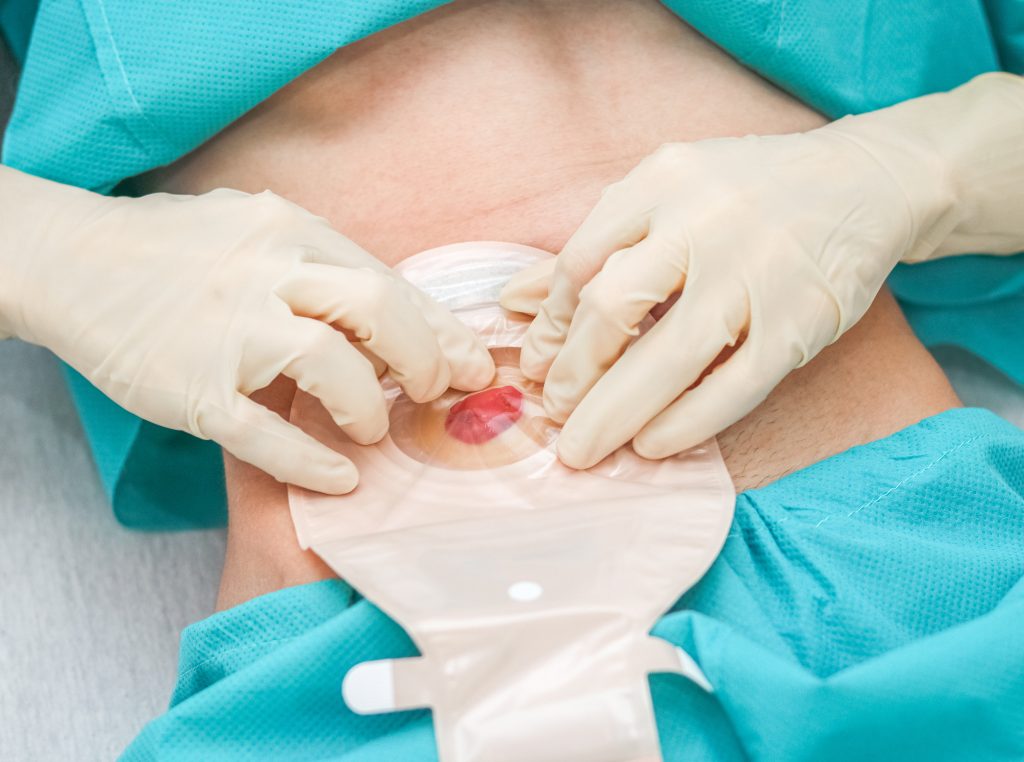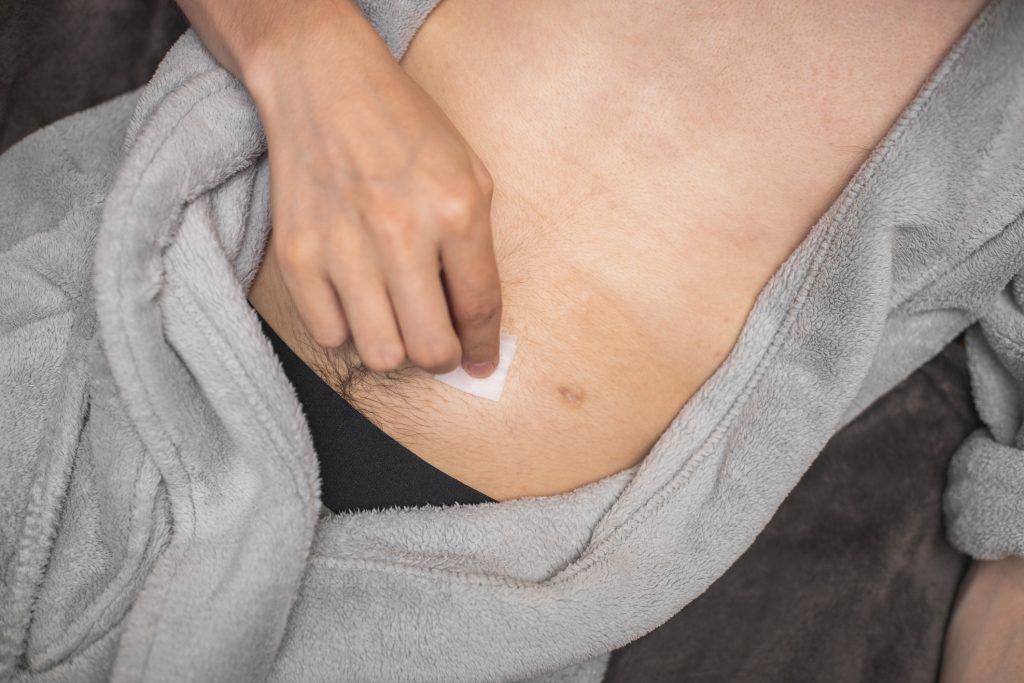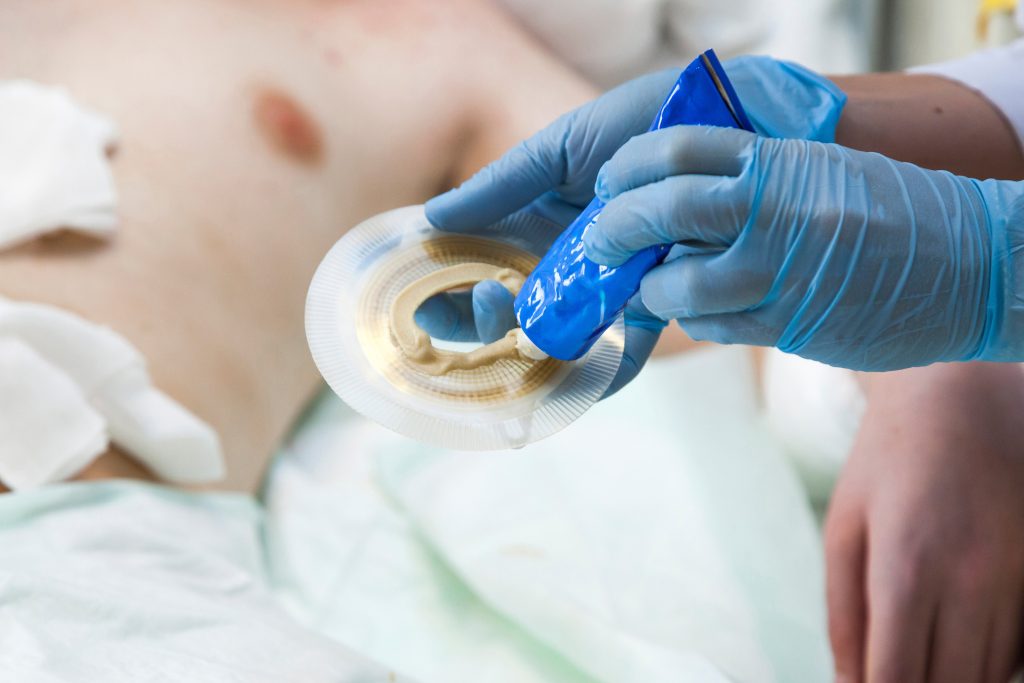Course
Stoma Site Marking
Course Highlights
- In this course we will learn about the advantages of stoma site marking before surgery
- You’ll also learn how to identify who can perform a stoma site marking assessment
About
Contact Hours Awarded: 1
Course By:
Michael York
MSN, RN
Begin Now
Read Course | Complete Survey | Claim Credit
➀ Read and Learn
The following course content
Surgical site marking has been a safety issue for decades. It is an important initiative to keep patients safe that The Joint Commission created a Universal Protocol for procedures/surgeries, including mandatory site verification/marking. Above all, we never want to harm a patient. We want to make sure that the patient is not only safe but also that they have the best opportunity for a fast recovery free from any complications. Traditionally, site marking was relegated to areas where there could be confusion; instances where two or more of an area (legs, arms, etc.) are examples. If the idea is to keep patients safe and to ensure the best possible outcome, why not include stoma sites?
Introduction
Surgical site marking has been a safety issue for decades. It is an important initiative to keep patients safe that The Joint Commission created a Universal Protocol for procedures/surgeries, including mandatory site verification/marking. Above all, we never want to harm a patient.
We want to make sure that the patient is not only safe but also that they have the best opportunity for a fast recovery free from any complications. Traditionally, site marking was relegated to areas where there could be confusion; instances where two or more of an area (legs, arms, etc.) are examples. If the idea is to keep patients safe and to ensure the best possible outcome, why not include stoma sites?
Definitions
Before discussing stoma site marking, we need to know what a stoma is. The word stoma is derived from the Greek word στόμα (stóma), which means mouth. Many healthcare providers use the terms stoma and ostomy interchangeably. A stoma is a surgical opening from the abdominal wall to the outside of the body. They can be created in both the gastrointestinal tract and the urogenital tract.
The stomas created in the gastrointestinal tract can be either colostomies or ileostomies. A colostomy is an opening in the abdominal wall that connects to the colon or large intestine, while an ileostomy connects to the small intestine. These stomas are used to divert fecal matter outside the body. From the urogenital tract, a urostomy is an opening where the ureters are connected to bowel tissue to divert urine to the outside body. In both instances, the stomas can be temporary or permanent, depending on the patient’s needs (2).


Self-Quiz
Ask Yourself...
- What does the Greek word stoma mean?
- What is the difference between a colostomy and an ileostomy?
Why Would Someone Need a Stoma?
A stoma creation may be needed for a variety of reasons. The four most common reasons are inflammatory bowel disease (IBD), colorectal cancer (CRC), trauma, and diverticulitis. The most common types of fecal stomas are the colostomy and the ileostomy. When CRC, trauma, or diverticulitis are the reasons for the stoma creation, the patient is often self-conscious about the stoma, and their body image is affected. Conversely, patients with IBD may welcome the stoma as a means of decreasing the inconvenient and embarrassing side effects associated with the disease (9).

Self-Quiz
Ask Yourself...
- What are two possible indications for a stoma?
Why Mark the Stoma Site?
As opposed to regular surgical sites, which are marked for almost purely safety reasons, there are many reasons to mark a stoma site before surgery:
Psychological support
Stomas bring about a change in the patient’s self-perception. A stoma changes a person’s body, and due to the nature of the stoma, which is to rid the body of waste, the patients often feel self-conscious. It is not always easy to accept a physical change to the body. During the stoma site selection session, the provider can discuss what the stoma is for and what to expect physically. It gives the patient time to accept the stoma psychotically (7).
Post-operative care of the stoma
The site marking session gives the provider time to discuss and provide education regarding stoma management. This is a time to set expectations. Caring for a stoma will be a new prospect for the patient. The patient and family must be educated on how to clean the stoma site and keep it free from infection. It also allows for the patient and provider to discuss pouch selection and how to apply the stool/urine collection apparatus (3, 7).
Quality of life
An appropriate stoma site selection will help the patient have the best possible quality of life post-operative. The provider must perform a full assessment to find the optimal stoma site. This assessment is performed to avoid post-operative complications associated with the stoma site selection. The evaluation should include observations of how the patient moves and how their body bends and twists when performing activities of daily living. Standing and sitting postures should also be considered when choosing an appropriate stoma site (3, 7).
Wear and tear
The site choice can also help predict the wear of the pouch and collection apparatus. This can give the patient an insight into the financial burden that the stoma may have over the period that the stoma will be present. It can also allow the patient to be prepared when the apparatus may need to be exchanged (7).
The stoma site marking session needs to be performed by qualified providers in conjunction with the patient. The patient’s input is vital in the stoma site selection. The way the patient moves and overall body image play important roles in proper stoma site choice (1).


Self-Quiz
Ask Yourself...
- What are two reasons to mark a stoma site before surgery?
- How does a stoma patient need psychological support?
- To preserve quality of life, what assessments should the provider make?
- What can proper stoma site marking help to predict?
Stoma Complications
There are many complications associated with stomas. When the proper stoma site has been chosen, these complications can be minimized or even eliminated. What contributes to, or is considered, a poor stoma site selection?
Where it is difficult for the patient to clean the stoma site area would result in poor selection. This could include areas where the patient cannot see the stoma or an area that is difficult to reach. This exemplifies why the patient must be included in the stoma site marking session. These scenarios can be avoided when the patient is involved in the stoma marking process before the stoma creation. When a stoma site is inaccessible or difficult for the patient to access, the chance of spillage when emptying the pouch is much greater. Spillage onto the patient’s clothing can further bring down the patient’s body image as odors associated with human waste can stay with the patient. When they see or smell that waste, reactions from others can also affect their body image and confidence. Others may feel that the patient has poor hygiene and cannot care for themselves (1, 7).
Pouch apparatus management is another issue that can be minimized with stoma site marking before surgery. Once a patient has an ostomy, the external collection system must be able to perform its job without hindrance. Proper stoma site selection gives the patient a better chance of having minimal pouch management complications. The patient should be able to see the stoma site. This will give the patient increased independence as, when they can see the stoma site, they can care for it.
It is optimal to choose a site where the entire pouch apparatus needs minimal changing. An area with the fewest skin creases is a better place to create the stoma. Skin creases around the stoma site may lead to leakage and a need for frequent apparatus change (1, 7, 8).
Skin integrity can be at risk when pouch management is compromised due to poor stoma site selection. The more a pouch apparatus needs to be changed, the more the adhesive is lifted off the skin, causing irritation that can lead to breakdown. When leakage around the apparatus is also present, the breakdown can increase exponentially. Stoma site leakage is a leakage of human waste products. When left on the skin for long periods, they can cause irritation and breakdown; when added to constant apparatus changes, irritation and breakdown are inevitable (6, 7).
Improper stoma site selection can lead to parastomal hernia formation and stomal prolapse. Placing the stoma within the rectus abdominis muscle can significantly decrease these complications (5, 7).


Self-Quiz
Ask Yourself...
- Why would a location that is difficult to clean be a poor stoma site?
- Why should the patient be able to see the stoma?
- What are some risks of frequently changing the stoma pouch apparatus?
- Within which muscle should the stoma be placed?
Who Can Site Mark?
Stoma site selection is a necessary process that needs to be performed by specially trained professionals. It should be noted that stoma site marking is not within the scope of the general practice registered nurse. This process requires additional training/certification and is usually associated with professionals within the gastrointestinal specialty. The most desirable clinicians to mark the stoma site would be the colorectal surgeon or the certified stoma nurse. When a stoma creation becomes an emergent procedure, these professionals may not be available to mark the stoma site. Emergency personnel and surgeons should be familiar with the stoma site marking process. They must consider the patient’s underlying disease and diagnosis, the surgical procedure, and the type of stoma to be created when marking the site (7).

Self-Quiz
Ask Yourself...
- Is stoma site marking within the scope of a general practice RN?
- Which two professionals should perform the stoma site marking?
- Who can do the stoma site marking in an emergent case?
Stoma Site Marking Procedure
Stoma site marking is a process/procedure like any other. Steps need to be taken to ensure a successful stoma site selection.
- Before starting the stoma site marking, the provider needs to collect certain items. A surgical skin marker must be on hand to mark the stoma site. The provider should also bring samples of different stoma pouches. A transparent dressing, a flat skin barrier, a measuring tape, and a scale should also be handy.
- Ensure that the patient has consented to and will participate in the site marking process. Educate the patient on the need for the stoma and on the stoma site marking process.
- Ensure good lighting.
- Inspect and examine the patient’s entire abdominal surface:
- Start with the patient in a sitting position. Both feet should be on the floor.
- All clothing over the abdomen should be removed. Just pushing the clothing out of the way could obscure or create skin folds and creases that may not be there when it is actually removed.
- Have the patient change positions from sitting to standing, lying down, and bending to view and assess all creases and folds. Moving the patient can also evaluate all scars and valleys. The provider should also check the skin turgor and the contours/curvatures of the abdomen.
- If the patient uses a wheelchair, have them sit in it and allow their body to relax into its usual position.
- Imagine a line where the incision will be. The stoma should be at least two inches away from this line. The adhesive skin barrier needs to fit without touching the incision.
- The patient’s rectus abdominis muscle should be identified. When a stoma is placed within this muscle, parastomal hernia formation and stoma prolapse rates are significantly decreased.
- Mark the spot. The spot should be two inches away from the incision line, with the rectus abdominis muscle, and within the patient’s field of view. By placing the stoma within the patient’s field of view, the patient may be able to maintain their independence by performing their own stoma care. All creases, folds, and scars should be avoided, and, if possible, the area should be below the belt line to conceal the pouch properly.
- The first marking should be done in temporary ink or with a sticker. With the temporary mark in place, a pouch collection apparatus is applied. Have the patient move around with the pouch in place. Once the optimal site is confirmed, a permanent marking can be made. Clean the area, allow it to dry, and use the sterile surgical skin marker.
- Cover the site with a transparent dressing and notify the surgeon of any difficulties finding a suitable stoma site. Remove any other markings on the abdominal wall. If multiple sites have been marked, number them in priority order.
- Educate the patient that this procedure is a guide; the site may change once in surgery. Document the stoma site marking. (7)

Self-Quiz
Ask Yourself...
- What should the provider bring to the stoma site marking assessment?
- Why should all clothing over the abdomen be removed for the stoma site marking assessment
- Why should the patient change positions During the stoma site marking assessment?
- Why should the provider first mark the stoma site using a temporary method?
- Why should an area below the belt line be chosen?
- Once marked, will the stoma always be placed on the marking?
Conclusion
No matter how you look at it, a stoma creation can be a traumatic experience for the patient. From body image to independence, stomas can cause various issues within the patient. Stoma site marking should be done before surgery to ensure the best possible outcome free from complications. Not only does the stoma site marking process allow for optimal positioning of the stoma, but it also gives the provider an excellent opportunity to educate the patient on the need for the stoma creation and possible complications. It also demonstrates to the patient that they are involved in the care plan and have input over what is being done to them.
References + Disclaimer
References
- Ambe, P. C., Kugler, C., Breuing, J., Grohmann, E., Friedel, J., Hess, S., & Pieper, D. (2022). The effect of preoperative stoma site marking on risk of stoma‐related complications in patients with intestinal ostomy — a systematic review and meta‐analysis. Colorectal Disease, 24(8), 904–917. https://doi.org/10.1111/codi.16118
- Babakhanlou, R., Larkin, K., Hita, A. G., Stroh, J., & Yeung, S.-C. (2022). Stoma-related complications and emergencies. International Journal of Emergency Medicine, 15(1). https://doi.org/10.1186/s12245-022-00421-9
- Gök, A. (2019). Complicated or not complicated: Stoma site marking before emergency abdominal surgery. Turkish Journal of Trauma and Emergency Surgery. https://doi.org/10.14744/tjtes.2019.48482
- Gray, M. (2020). Context for practice. Journal of Wound, Ostomy & Continence Nursing, 47(3), 211–212. https://doi.org/10.1097/won.0000000000000649
- Hoh, S., & Watters, D. (2023). The best stoma in an emergency. World Journal of Surgery, 47(11), 2865–2866. https://doi.org/10.1007/s00268-023-07151-w
- Hsu, M.-Y., Lin, J.-P., Hsu, H.-H., Lai, H.-L., & Wu, Y.-L. (2020). Preoperative stoma site marking decreases stoma and peristomal complications. Journal of Wound, Ostomy & Continence Nursing, 47(3), 249–256. https://doi.org/10.1097/won.0000000000000634
- Khan MA, Bhat MA, Magray JA, Mehraj A, Wani RA, Parray FQ, et al. Stoma Site Selection: Why and How?. Ann Surg Edu. 2019; 1(1): 1004. https://www.researchgate.net/publication/339774476_Stoma_Site_Selection_Why_and_How_Surgical_Techniques
- Kim, Y., Jang, H., & Lee, Y. (2021). The effectiveness of preoperative stoma site marking on patient outcomes: A systematic review and meta‐analysis. Journal of Advanced Nursing, 77(11), 4332–4346. https://doi.org/10.1111/jan.14915
- Petersén, C., & Carlsson, E. (2021). Life with a stoma—coping with daily life: Experiences from focus group interviews. Journal of Clinical Nursing, 30(15-16), 2309–2319. https://doi.org/10.1111/jocn.15769
- Zwiep, T. M., Helewa, R. M., Robertson, R., Moloo, H., Hill, R., Chaplain, V., & Harley, C. (2022). Preoperative stoma site marking for fecal diversions (ileostomy and colostomy): Position statement of the canadian society of colon and rectal surgeons and nurses specialized in wound, ostomy and continence canada. Canadian Journal of Surgery, 65(3), E359–E363. https://doi.org/10.1503/cjs.022320
Disclaimer:
Use of Course Content. The courses provided by NCC are based on industry knowledge and input from professional nurses, experts, practitioners, and other individuals and institutions. The information presented in this course is intended solely for the use of healthcare professionals taking this course, for credit, from NCC. The information is designed to assist healthcare professionals, including nurses, in addressing issues associated with healthcare. The information provided in this course is general in nature and is not designed to address any specific situation. This publication in no way absolves facilities of their responsibility for the appropriate orientation of healthcare professionals. Hospitals or other organizations using this publication as a part of their own orientation processes should review the contents of this publication to ensure accuracy and compliance before using this publication. Knowledge, procedures or insight gained from the Student in the course of taking classes provided by NCC may be used at the Student’s discretion during their course of work or otherwise in a professional capacity. The Student understands and agrees that NCC shall not be held liable for any acts, errors, advice or omissions provided by the Student based on knowledge or advice acquired by NCC. The Student is solely responsible for his/her own actions, even if information and/or education was acquired from a NCC course pertaining to that action or actions. By clicking “complete” you are agreeing to these terms of use.
➁ Complete Survey
Give us your thoughts and feedback
➂ Click Complete
To receive your certificate
